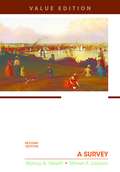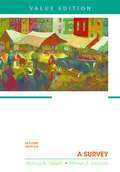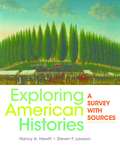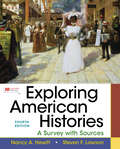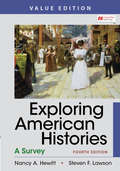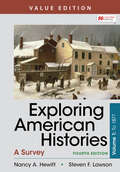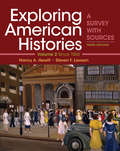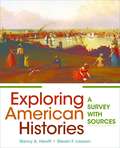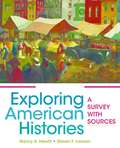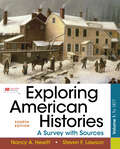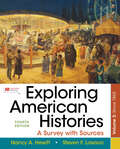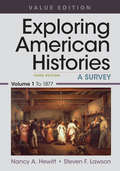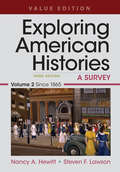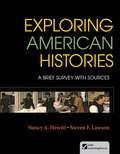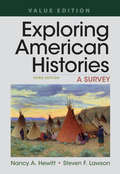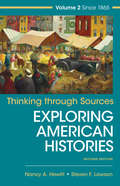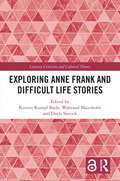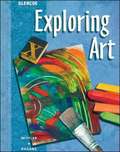- Table View
- List View
Exploring America, Part 1 (Columbus to Reconstruction)
by Ray NotgrassThis curriculum will guide you through the story of our country from the first European explorers to the present. We place great emphasis on original documents and speeches because these allow the participants in history to tell the story from their own perspective. This curriculum also introduces some of the great literature that Americans have produced: novels, short stories, autobiographies, memoirs, essays, poems, hymns, and other kinds of writing. The written and spoken word has a profound ability to move hearts and minds. This course also explores the significance of faith with regard to history. Faith is connected with history in two ways. First, people have often been motivated to act because of their faith in God. For instance, faith motivated the Pilgrims on the Mayflower to seek a new land in which to live. Faith caused people to oppose slavery. Faith has been expressed often in the speeches and documents that Americans have produced. We recognize and highlight the importance of faith throughout the American story. A second way that faith should be connected to history is by looking at the overall story of American history through the eyes of faith. We encourage students to think about the faith lessons that they can learn from people and events in history. For instance, many God-fearing Americans owned slaves and had a strong prejudice against blacks. We need to understand what caused those Christian people to be blinded by their culture and how they missed the example of Jesus and the teaching of Scripture about this issue (see John 4:7-9, Galatians 3:28, and Ephesians 2:19). This might help us realize cultural blindnesses we suffer today. A study of history can inform, challenge, and strengthen our own faith. "
Exploring America, Part 2 (Late 1800's to Present)
by Ray NotgrassThis curriculum will guide you through the story of our country from the first European explorers to the present. We place great emphasis on original documents and speeches because these allow the participants in history to tell the story from their own perspective. This curriculum also introduces some of the great literature that Americans have produced: novels, short stories, autobiographies, memoirs, essays, poems, hymns, and other kinds of writing. The written and spoken word has a profound ability to move hearts and minds. This course also explores the significance of faith with regard to history. Faith is connected with history in two ways. First, people have often been motivated to act because of their faith in God. For instance, faith motivated the Pilgrims on the Mayflower to seek a new land in which to live. Faith caused people to oppose slavery. Faith has been expressed often in the speeches and documents that Americans have produced. We recognize and highlight the importance of faith throughout the American story. A second way that faith should be connected to history is by looking at the overall story of American history through the eyes of faith. We encourage students to think about the faith lessons that they can learn from people and events in history. For instance, many God-fearing Americans owned slaves and had a strong prejudice against blacks. We need to understand what caused those Christian people to be blinded by their culture and how they missed the example of Jesus and the teaching of Scripture about this issue (see John 4:7-9, Galatians 3:28, and Ephesians 2:19). This might help us realize cultural blindnesses we suffer today. A study of history can inform, challenge, and strengthen our own faith. "
Exploring American Citizenship
by Globe FearonThe Student Texts and Student Workbooks provide helpful charts, tables, and maps that allow students to look closely at all critical aspects of U.S. government, including citizenship, the justice system, foreign policy, and much more. The book helps students understand the development of the government and the rights and laws of local, state, and federal governments.
Exploring American Histories, Volume 1, Value Edition: A Survey
by Steven F. Lawson Nancy A. HewittExploring American Histories opens an entirely new window into the many histories of the nation’s past. It integrates an unprecedented number of primary sources—both written and visual—in a unique building blocks approach that enables students to hone their analysis skills while they actively learn the fundamental concepts of American history. By weaving sources into the story and culminating in multidocument projects around a single topic at the end of each chapter, the book brings history to life while helping students understand how sources form the basis of historical narratives and how to think critically about them.
Exploring American Histories, Volume 2, Value Edition: A Survey
by Steven F. Lawson Nancy A. HewittExploring American Histories opens an entirely new window into the many histories of the nation’s past. It integrates an unprecedented number of primary sources—both written and visual—in a unique building blocks approach that enables students to hone their analysis skills while they actively learn the fundamental concepts of American history. By weaving sources into the story and culminating in multidocument projects around a single topic at the end of each chapter, the book brings history to life while helping students understand how sources form the basis of historical narratives and how to think critically about them.
Exploring American Histories, Combined Volume: A Survey with Sources
by Steven F. Lawson Nancy A. HewittExploring American Histories opens an entirely new window into the many histories of the nation's past. It integrates an unprecedented number of primary sources--both written and visual--in a unique building blocks approach that enables students to hone their analysis skills while they actively learn the fundamental concepts of American history. By weaving sources into the story and culminating in multidocument projects around a single topic at the end of each chapter, the book brings history to life while helping students understand how sources form the basis of historical narratives and how to think critically about them. The possibilities for active learning and assessment expand with the LaunchPad e-book and course space which adds a wealth of time-saving teaching and learning tools at instructors' fingertips. LaunchPad comes with LearningCurve, an adaptive and automatically graded learning tool that students love to use and that, when assigned, ensures students come to class prepared. Easy to integrate into your campus LMS, and featuring additional primary sources, summative quizzing, videos, new autograded source-based questions, and new autograded exercises that guide students to use sources to build an argument, LaunchPad provides an easy and fun way to help students learn about American history while helping them make progress toward learning outcomes.
Exploring American Histories, Combined Volume: A Survey with Sources
by Nancy Hewitt Steven LawsonExploring American Histories guides you through the nation’s history, giving voice to an extraordinary variety of Americans, while teaching you to work with historical documents in the same way as professional historians.
Exploring American Histories, Value Edition, Combined Volume: A Survey
by Steven F. Lawson Nancy A. HewittThe diverse histories of the United States that come to life in Exploring American Histories are available at a lower price in a compact format. The two-color Value Edition includes the full narrative and all maps and select images from the comprehensive text.
Exploring American Histories, Value Edition, Combined Volume: A Survey with Sources
by Steven F. Lawson Nancy A. HewittExploring American Histories guides you through the nation’s history, giving voice to an extraordinary variety of Americans, while teaching you to work with historical documents in the same way as professional historians. This Value Edition is the lowest priced print version of the text.
Exploring American Histories, Value Edition, Volume 1: A Survey
by Nancy Hewitt Steven LawsonExploring American Histories guides you through the nation’s history, giving voice to an extraordinary variety of Americans, while teaching you to work with historical documents in the same way as professional historians. This Value Edition is the lowest priced print version of the text.
Exploring American Histories, Value Edition, Volume 2: A Brief Survey with Sources
by Nancy Hewitt Steven LawsonExploring American Histories guides you through the nation’s history, giving voice to an extraordinary variety of Americans, while teaching you to work with historical documents in the same way as professional historians. This Value Edition is the lowest priced print version of the text.
Exploring American Histories, Vol. 2: A Brief Survey With Sources
by Steven F. Lawson Nancy A. HewittExploring American Histories offers an entirely new approach to teaching the U.S. survey that puts investigating sources and thinking about the many stories of American history right at the center of your course. The distinctive format integrates primary documents and a brief narrative into one cost-effective and easy-to-use volume. Exploring American Histories features Bedford/St. Martin’s new digital history tools, including LearningCurve, an adaptive quizzing engine that garners over a 90% student satisfaction rate, and LaunchPad, the all new interactive e-book and course space that puts high quality easy-to-use assessment at your figertips. Easy to integrate into your campus LMS, and featuring video, additional primary sources, a wealth of adaptive and summative quizzing, and more, LaunchPad cements student understanding of the text while helping them make progress toward learning outcomes. It’s the best content joined up with the best technology. Available in combined and split volumes and in a number of affordable print and digital formats.
Exploring American Histories, Volume 1: A Survey with Sources
by Steven F. Lawson Nancy A. HewittExploring American Histories opens an entirely new window into the many histories of the nation's past. It integrates an unprecedented number of primary sources--both written and visual--in a unique building blocks approach that enables students to hone their analysis skills while they actively learn the fundamental concepts of American history. By weaving sources into the story and culminating in multidocument projects around a single topic at the end of each chapter, the book brings history to life while helping students understand how sources form the basis of historical narratives and how to think critically about them. The possibilities for active learning and assessment expand with the LaunchPad e-book and course space which adds a wealth of time-saving teaching and learning tools at instructors' fingertips. LaunchPad comes with LearningCurve, an adaptive and automatically graded learning tool that students love to use and that, when assigned, ensures students come to class prepared. Easy to integrate into your campus LMS, and featuring additional primary sources, summative quizzing, videos, new autograded source-based questions, and new autograded exercises that guide students to use sources to build an argument, LaunchPad provides an easy and fun way to help students learn about American history while helping them make progress toward learning outcomes.
Exploring American Histories, Volume 2: A Survey with Sources
by Steven F. Lawson Nancy A. HewittExploring American Histories opens an entirely new window into the many histories of the nation's past. It integrates an unprecedented number of primary sources--both written and visual--in a unique building blocks approach that enables students to hone their analysis skills while they actively learn the fundamental concepts of American history. By weaving sources into the story and culminating in multidocument projects around a single topic at the end of each chapter, the book brings history to life while helping students understand how sources form the basis of historical narratives and how to think critically about them. The possibilities for active learning and assessment expand with the LaunchPad e-book and course space which adds a wealth of time-saving teaching and learning tools at instructors' fingertips. LaunchPad comes with LearningCurve, an adaptive and automatically graded learning tool that students love to use and that, when assigned, ensures students come to class prepared. Easy to integrate into your campus LMS, and featuring additional primary sources, summative quizzing, videos, new autograded source-based questions, and new autograded exercises that guide students to use sources to build an argument, LaunchPad provides an easy and fun way to help students learn about American history while helping them make progress toward learning outcomes.
Exploring American Histories, Volume One: A Survey with Sources
by Nancy Hewitt Steven LawsonExploring American Histories guides you through the nation’s history, giving voice to an extraordinary variety of Americans, while teaching you to work with historical documents in the same way as professional historians.
Exploring American Histories, Volume Two: A Survey with Sources
by Nancy Hewitt Steven LawsonExploring American Histories guides you through the nation’s history, giving voice to an extraordinary variety of Americans, while teaching you to work with historical documents in the same way as professional historians.
Exploring American Histories: A Brief Survey With Sources
by Steven F. Lawson Nancy A. HewittExploring American Histories opens an entirely new window into the many histories of the nation’s past. It integrates an unprecedented number of primary sources—both written and visual—in a unique building blocks approach that enables students to hone their analysis skills while they actively learn the fundamental concepts of American history. By weaving sources into the story and culminating in multidocument projects around a single topic at the end of each chapter, the book brings history to life while helping students understand how sources form the basis of historical narratives and how to think critically about them.
Exploring American Histories: A Brief Survey With Sources
by Steven F. Lawson Nancy A. HewittExploring American Histories opens an entirely new window into the many histories of the nation’s past. It integrates an unprecedented number of primary sources—both written and visual—in a unique building blocks approach that enables students to hone their analysis skills while they actively learn the fundamental concepts of American history. By weaving sources into the story and culminating in multidocument projects around a single topic at the end of each chapter, the book brings history to life while helping students understand how sources form the basis of historical narratives and how to think critically about them.
Exploring American Histories: A Brief Survey with Sources
by Steven F. Lawson Nancy A. HewittThis book written in an innovative format makes broad and diverse American history accessible to students and instructors interested in a more active learning and teaching style.
Exploring American Histories: A Survey
by Nancy Hewitt Steven LawsonThe diverse histories of the United States that come to life in Exploring American Histories are available at a lower price in a compact format. This two-color Value Edition includes the unabridged narrative and all maps, figures, tables, and select images from the comprehensive text.
Exploring American Histories: A Survey with Sources (American Histories #1)
by Steven F. Lawson Nancy A. HewittOur book offers a new kind of U.S. history survey text, one that makes a broad and diverse American history accessible to a new generation of students and instructors interested in a more engaged learning and teaching style. To accomplish this, we carefully weave an unprecedented number of written and visual primary sources, representing a rich assortment of American perspectives, into each chapter.
Exploring American Histories: Thinking through Sources
by Steven F. Lawson Nancy A. HewittNEW Thinking through Sources for Exploring American Histories is a two-volume primary sources reader that supplements the document projects in the textbook. Each chapter of the reader presents five carefully selected documents that connect to topics in each chapter of Exploring American Histories. Headnotes placed strategically before each document give students just enough context, and Interpret the Evidence and Put It in Context questions at the end of each chapter provide a starting point for classroom discussion or a written assignment. This collection of sources is available both in print and in LaunchPad with innovative auto-graded assessment.
Exploring American History
by John O'ConnorIn this book you will read the story of your country from its beginnings to the present day. The people who tell this story are called historians. You may wonder how historians find out what happened in the past. Historians are like detectives. They use many kinds of clues to learn about the way people lived and what they did in years gone by.
Exploring Anne Frank and Difficult Life Stories (Literary Criticism and Cultural Theory)
by Kirsten Kumpf Baele Waltraud Maierhofer Doyle StevickThis volume, grounded in the Diary of a Young Girl and its continued appeal to readers of all ages, sees both promise in the relevance of Anne Frank’s story in the twenty‑first century, and potential for new ways of teaching her story and those of other genocides and human right violations. Engaging Anne Frank with these other cases clarifies the distinct nature of the Holocaust, and we build on the fact that the diary touches areas of deep interest, especially to young people, and that it has been read as a monument to resisting hate, which is itself a prerequisite for educating citizens of more diverse and inclusive societies. The diverse contributions and viewpoints in this volume illustrate how rich the ongoing engagement with Anne Frank and her legacy remain.
Exploring Art
by Rosalind Ragans Gene MittlerEXPLORING ART takes a media approach to art, giving students insights into the ways artists are inspired, and the reasons they choose particular media to realize their artistic visions. Focusing on the elements and principles of art, students learn about various media and techniques, such as drawing, painting, printmaking and sculpting, as the chapters interweave compelling lessons on art, art history, aesthetics, and art criticism with opportunities for studio production.


